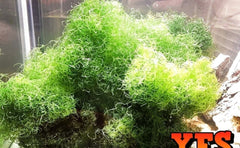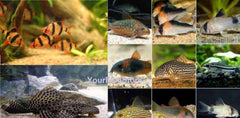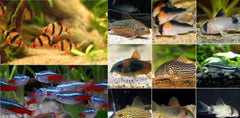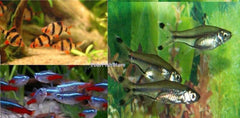X2 Redtail / Tiger Shovelnose Hybrid Catfish Sml/Med 1"-2" | X10 Assorted South American Cichlids
Ebay
$ 156.53

THIS PACKAGE IS FOR:
X2 REDTAIL / TIGER SHOVELNOSE HYBRID CATFISH SM/MD 1"-2"
x10 ASSORTED SOUTH AMERICAN CICHLIDS
*********************************************************************
X2 REDTAIL / TIGER SHOVELNOSE HYBRID CATFISH SM/MD 1"-2"
Origin
Brasil and environs
Maximum Size
Three to four feet
Longevity
15 years – probably more
Housing
30 Gallon +
Security
Likes caves when small
Substrate
None needed
Temperature
Prefers 70 to 80o
Attitude
Loafs all day. Eats all night.
Foods
Anything plus rocks
Water
Keep clean
Threat
Heavy metals, ammonia
The Red-tailed Catfish Phractocephalus hemioliopterus is easily recognized and one of the most attractive of the catfish species. As a member of the Pimelodidae family it is long whiskered, but Its beautiful red tail and white belly are its unmistakable characteristics. This fish is the only member of its genus and with its distinct appearance, it's only confused with an occasional hybrid that may appear from time to time. It is also known as the South American Red Tailed Catfish, Banana Catfish and Redtail Catfish. Flat-nosed Catfish and Antenna Catfish are generic names applied to this fish as well as some other members of its family.
This catfish gets really big. They can reach 3 feet or more in captivity and there are reports of specimens reaching up to 5 feet in the wild. Because of their large size they are a favorite game fish and anglers love them. The International Game Fish Association (IGFA) reports that the current world record weight for this fish is a whopping 123 lbs. 7 oz. (56 kg). This world record is held by Gilberto Fernandes for a specimen he caught in the Amazon River on April 3, 2010.
Even though the Red-tailed catfish is one of the larger fish in the Amazon, this is not a food fish for the natives. It has a dark colored flesh and according to Dr. Herbert R. Axelrod, in his book 'Aquarium Fishes of the World (1998)', the natives will only eat white flesh. According to Wikipedia, in an attempt to develop a viable food fish they have been hybridized with other fish species, like the Pseudoplatystoma sp. of Tiger Shovelnose. The resultant hybrids are generally known as Tiger Redtail Catfish. These will sometimes show up in the aquarium hobby under various common names.
Despite their attractive appearance, these catfish get very large and so are not recommended for the average aquarist. They are only able to be kept in a smaller aquarium as juveniles. Being fast growers they will quickly need a larger and larger aquarium. A minimum sized tank would be at least 1000 gallons, and for the largest sized ones it could easily be 1500 gallons or more. This is a huge tank, making them not really suitable for most homes. They are best left to public aquariums or only kept by advanced aquarists with the space and means to provide them with the appropriate habitat and care for their entire lifespan.
Red-tailed Catfish are not real active and would prefer a large cave or den to hang out in. If the tank is dimly lit, then just a few large pieces of bogwood will suffice. These fish are actually quite peaceful, but they have a big mouth and a hearty appetite. They can't be kept with smaller fish as these tank-mates will become lunch sooner or later. They are also territorial with their own kind as well as other catfish from the Pimelodidae family,but are fine kept with other same-sized large fish with a similar temperament.
x10 Assorted South American Cichlid SM/MD FRY - FRESH WATER LIVE FISH FREE SHIPPING
They will be scooped out our holding tanks. We cannot guarantee we will be able to scoop ALL different types, but we will try to get a good variety.
This package is for x10 Assorted South American Cichlids FRY / Approx 1"-2" EACH
Possible Random Selection that may be included when we scoop them out of holding tub:
Jack Dempsey Cichlid
Blue Acara Cichlid
Keyhole Cichlid
Green Severum Cichlid
German Blue Ram Cichlid
Peacock Bass Cichlid
Dovii Cichlid
Green Terror Cichlid
Apistogramma Pucallpaensis Cichlid
Thorichthys Ellioti Cichlid
Blue Kribensis Cichlid
Golden Dwarf Acara Cichlid
Vieja Argentea Cichlid
Chocolate Cichlid
Zebra Pike Cichlid
Neetroplus Nematopus Cichlid
Geophagus Altifrons Cichlid
Jewel Cichlid
Gold Severum Cichlid
Acarichthys Heckelii Cichlid
Texas Cichlid
Kribensis Cichlid
Pink Convict Cichlid
Geophagus Jurupari Cichlid
Sajica Cichlid
Krobia Itanyi Cichlid
Rainbow Cichlid
Firemouth Meeki Cichlid
Checkerboard Cichlid
Aequidens Diadema Cichlid
Longfin Gold Ram Cichlid
Paratilapia Bleekeri Cichlid
Vieja Argentea Cichlid
Bolivian Ram Cichlid
Electric Blue Ram Cichlid
Geophagus Brasiliensis Cichlid
Fire Red Apisto. Agassizi Cichlid
Herichthys Bocourti Cichlid
Black Convict Cichlid
Blonde Honduran Red Point Convict Cichlid
Albino Kyoga Red Xystichromis sp. Cichlid
Apistogramma Erythrura Cichlid
Balloon Blue Ram Cichlid
Balloon Electric Blue Ram Cichlid
Bandit Cichlid
Double Red Apisto Cacatouides Cichlid
Electric Blue Acara
Geophagus sp. Rio Negro Cichlid
South American cichlids are attractive, active, are generally quite durable fish. They are found in a range of sizes and with some very beautiful coloration.
Their behaviors are very intriguing, and many interact with their keepers and their environment making them favorite aquarium fish for many hobbyists.
Cichlids are found around the globe, in the Americas, Africa and parts of Asia. The “type specimen” for the cichlid family is the South American cichlid Cichla ocellaris, commonly known as the Peacock Bass or Peacock Cichlid. Thus the American cichlids are sometimes referred to as the “true cichlids” though all species are actually true cichlids.
The South American Cichlids or New World Cichlids are those found primarily in Central and South America, with a number of species native to Mexico, and the Texas Cichlid found in the southern part of North America. The actual number of cichlid species is unknown but estimated at more than 2000, with at least 1300 species scientifically described. South American Cichlids and Central American Cichlids are estimated at about 570 species.
They are categorized as "secondary freshwater fish" - meaning their ancestors were marine fish. It is believed that cichlids moved to freshwaters from the marine environment, and they have features relating to a number of marine species including the damsels, wrasses, parrot fish, and surfperches. This helps to explain why many species can do well in salty water, and in fact some species extend their range into parts of the ocean.


Quick Supply Links - $3.99 Shipping On All Supplies
Protein Skimmers - Lights - Fish Food - Pumps - Aquariums - Chillers - Decorations - Food - Filters - Medication - Nets - Salt - Substrate - Sump Tanks - UV Sterlizers - Cleaning Supplies - Nets - Koi Nets - Substrate - CO2 - Coral Viewers

Ebay Livestock & Supplies
QUESTIONS & ANSWERS
Have a Question?
Be the first to ask a question about this.














